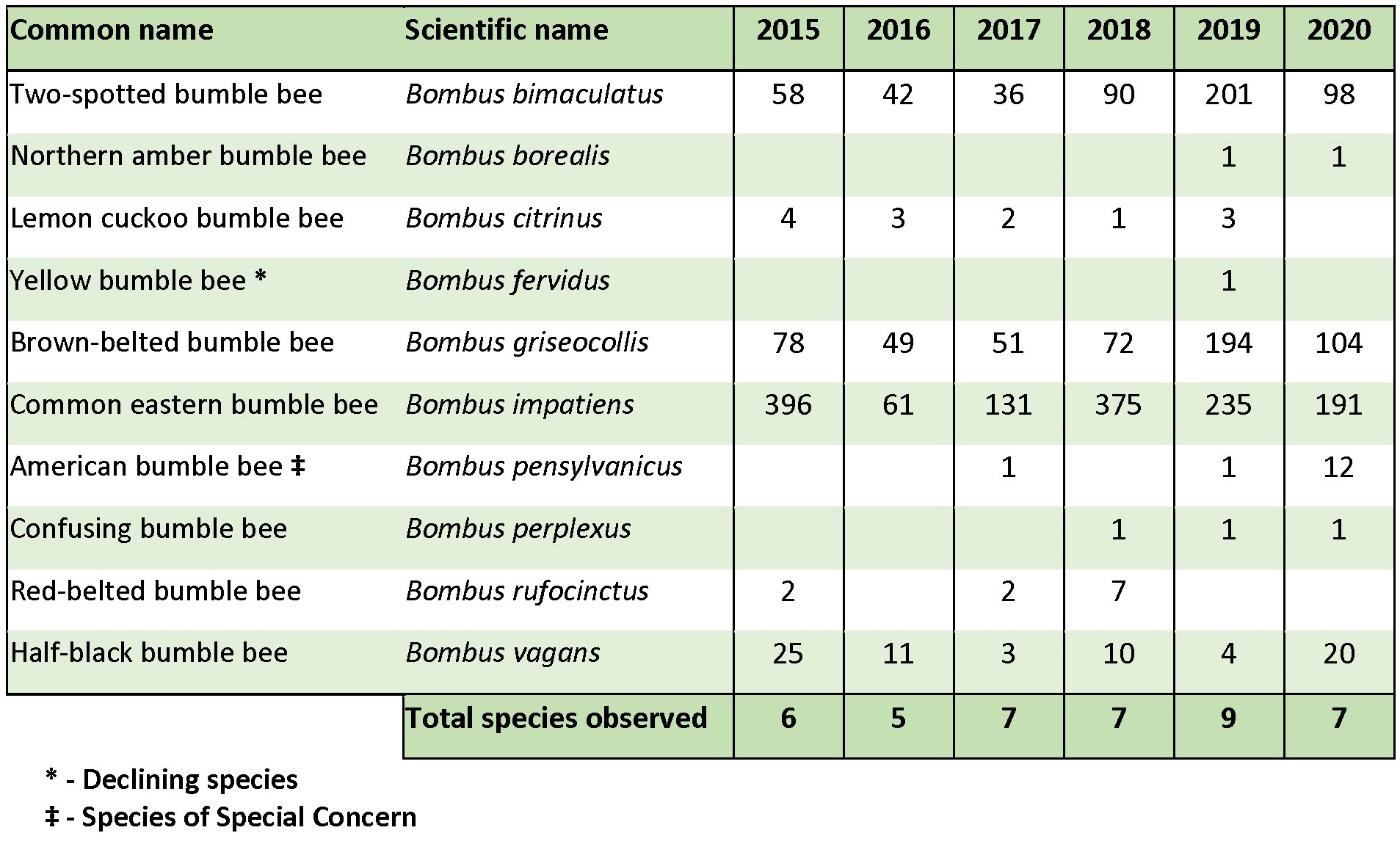Have you heard the term “community science”? Community science gives everyone an opportunity to participate in science and conservation. Community scientists help researchers simply by getting outside and observing the natural world, all the while collecting valuable data that result in greater numbers of species records across larger geographical areas than can be accomplished by researchers and conservation practitioners alone.

Staff from Wildlife Preservation Canada train community science volunteers how to undertake bumble bee surveys at Pinery Provincial Park. (Photo: Hayley Tompkins.)
Pinery Provincial Park, commonly referred to as The Pinery, is in Ontario, near the southern tip of Lake Huron. Covering over 25 square kilometers (almost 10 square miles), the park contains a variety of ecosystems—including rare oak savanna, coastal dunes, and a provincially significant wetland—and since 2015, it has been the site of Wildlife Preservation Canada’s Native Pollinator Initiative, a hands-on Bumble Bee Watch community science survey program. This program engages participants in bumble bee conservation by teaching them the same bumble bee survey techniques that professional researchers use, and by providing them with the equipment and know-how to independently monitor native bumble bees at The Pinery. Over the last six years, not only have our community scientists been able to enjoy the beauty of The Pinery, they have also helped us create a robust long-term dataset by contributing nearly two thousand species-specific bumble bee observations to Bumble Bee Watch.
There is a growing need for long-term datasets because they are a baseline description of a community that can be used to provide insight into changes in species diversity over time. They also can help us to differentiate between population-level changes that describe natural fluctuations from those that might indicate a species is threatened. For the Native Pollinator Initiative, monitoring changes like these is an important step in understanding the bumble bees of The Pinery.

Biologist Genevieve Rowe (right) leading a bumble bee community science training workshop. (Photo: Julia Millen.)
Thanks to weekly surveys undertaken throughout the summer months by our committed community scientists, we have seen just how the bumble bee community at The Pinery can vary from one year to the next (Table 1). In some years (such as 2015 and 2016), the total species diversity was two-thirds or less of what it was in other years (such as 2019). The most abundant species each year has been the common eastern bumble bee, with two others—the two-spotted and brown-belted—annually vying for second place.

Table showing the total annual observations (count) for each bumble bee species observed by community scientists in Pinery Provincial Park‘s Bumble Bee Watch community science program. (Data from BumbleBeeWatch.org and Wildlife Preservation Canada.)
This dataset has also been a reminder of the important role structural diversity across landscapes plays on dictating the composition of the bumble bee community on different sites in the park. Check out our bumble bee observations in this StoryMap to see just what we mean!
Datasets like these that monitor a single location to this extent are rarely accomplished without dedicated volunteers like ours, and we are lucky that they have managed to capture rare species observations that would have otherwise been missed during a single visit or single survey year. Had such a survey program been in place twenty years ago, we can’t help but wonder what kind of impact a dataset that provided species-specific records across days, weeks, months, and years, like the one our volunteers have built more recently, might have had on preventing the loss of rare bumble bees from The Pinery. This park is the last place the endangered rusty patched bumble bee (Bombus affinis) was recorded in Canada, and the last for the endangered gypsy cuckoo bumble bee (Bombus bohemicus) in Ontario. We are grateful that this program continues to provide us with an opportunity to search for remnant populations of these and other at-risk species, and to better understand bumble bee population dynamics so that we can develop and implement better management and recovery strategies.

This rusty patched bumble bee (Bombus affinis) was spotted in Wisconsin. The species is also endangered in the United States. (Photo: Xerces Society / Rich Hatfield.)
Further Reading
Sign up to contribute sightings from your area to Bumble Bee Watch.
Learn more about how to protect bumble bees.
Quick tips on how you can support the life cycle of bumble bees: Bumble Bee Conservation (brochure)
Detailed guidance on Conserving Bumble Bees by creating and managing habitat.
Genevieve Rowe, Lead Biologist—Native Pollinator Initiative: Genevieve leads Wildlife Preservation Canada's native pollinator recovery programs across Canada. She began working with pollinators in 2013, and has since gained extensive experience in the fields of pollinator taxonomy and systematics, ecology, and conservation, and has taken part in various species at-risk monitoring and recovery programs, both nationally and internationally.
Hayley Tompkins, Ontario Program Coordinator—Native Pollinator Initiative: Hayley is Wildlife Preservation Canada's program coordinator for bumble bee recovery efforts in Ontario. She is currently pursuing a MSc degree from the University of Guelph, exploring the nesting ecology of bumble bees through the use of artificial domiciles.



